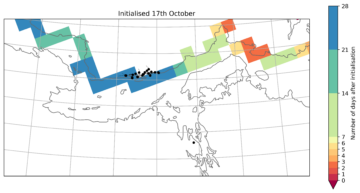AI for smart conservation
AI for smart conservation
- Start date
- 1 July, 2022
- End date
- 30 October, 2024
In the AI for smart conservation project, BAS are collaborating with local ecologists and conservation agencies to develop decision-making tools informed by sea ice forecasts. By combining satellite observations, GPS tracking and AI-forecasting with local expert knowledge, we develop AI-informed systems which can give early-warning of wildlife movement and distribution. This information can empower regional experts to design adaptive management plans, helping to better protect vulnerable polar wildlife.
Climate change is an increasingly pervasive threat to global biodiversity. Animal populations in the rapidly changing Arctic are often seen as a litmus test for the response of wildlife to climate change, particularly those whose life histories are inextricably tied to sea ice, such as polar bears, walrus, and certain caribou populations. As Arctic species navigate their increasingly unpredictable and fast-diminishing sea ice habitat, they simultaneously face pressure from shipping, fishing, mining and tourism industries drawn to the opening ocean. Conservation practitioners must develop adaptive management plans which are effective in these rapidly changing environments.
In recent years, advances in the field of AI-based sea ice forecasting have enabled more accurate forecasts of sea ice conditions. One example is IceNet, an in-development operational AI model, which forecasts daily pan-Arctic sea ice concentration (SIC) up to three months into the future at a 25km2 grid-cell resolution. IceNet forecast maps have the potential to inform dynamic conservation and management plans, by providing early-warning of ice-dependent species seasonal movement patterns.
Predicting Dolphin and Union caribou migration times
In this case study, BAS are working with the Government of Nunavut and WWF to develop a novel migration early-warning system for endangered Dolphin and Union (DU) caribou. DU caribou migrate across sea ice in the Coronation Gulf (Canadian Arctic) twice a year, however due to climate change DU caribou are being forced to migrate later, and over less stable ice (Figure 1). Icebreaking by vessels also poses a risk, delaying migrations and potentially forcing caribou into open leads. Being able to predict when the caribou are expected to cross the ice allows conservationists to make adaptive plans, for instance alerting vessel operators when to avoid vital migration routes.
Figure 1 : GPS collared caribou migrating across sea ice in the Coronation Gulf during the autumn freeze up. Tracks overlaid on 25km OSI-SAF (left) and 6km AMSR2 data (right). We can see the caribou wait on the south coast of Victoria Island for the sea ice to reach safe levels for crossing. Using IceNet we can predict when the ice will form, and therefore give early-warning for when the caribou are likely to begin their migration.
By linking satellite observations of sea ice concentration (SIC) with GPS movement records, the team were able to establish what SIC the caribou wait for before beginning their autumn migration. Using IceNet we can forecast when these SIC values are expected to be met, and produce output maps which can guide local experts on likely crossing times (Figure 2). The team’s software engineers are integrating these outputs into an online platform which can be accessed by local agencies, allowing safe upload of real-time collar locations to better guide decision-making. The end goal is a human-expert centred decision-support tool, which can be used for quick and easy assessment of forecast information to inform conservation, management and policy.

Future work
Following the success of the caribou migration case study, the team are working with stakeholders to explore applications for other Arctic species. Examples include predicting when polar bears are most likely to arrive on land near to communities to mitigate against human-polar bear conflict, anticipating when walrus are expected to haulout on land in large numbers to avoid disturbance and fatal stampede events, and predicting when key cetacean migration routes (“blue corridors”) will be most active to mitigate against ship noise and strikes.
James Byrne
Principal Software Engineer
Digital Innovation Team, Artificial Intelligence (AI) Lab, BAS IT team
Scott Hosking
Environmental Data Scientist
Artificial Intelligence (AI) Lab, BAS Science Strategy Executive Group
Martin Rogers
Machine Learning Research Scientist
Artificial Intelligence (AI) Lab, BAS Science Strategy Executive Group